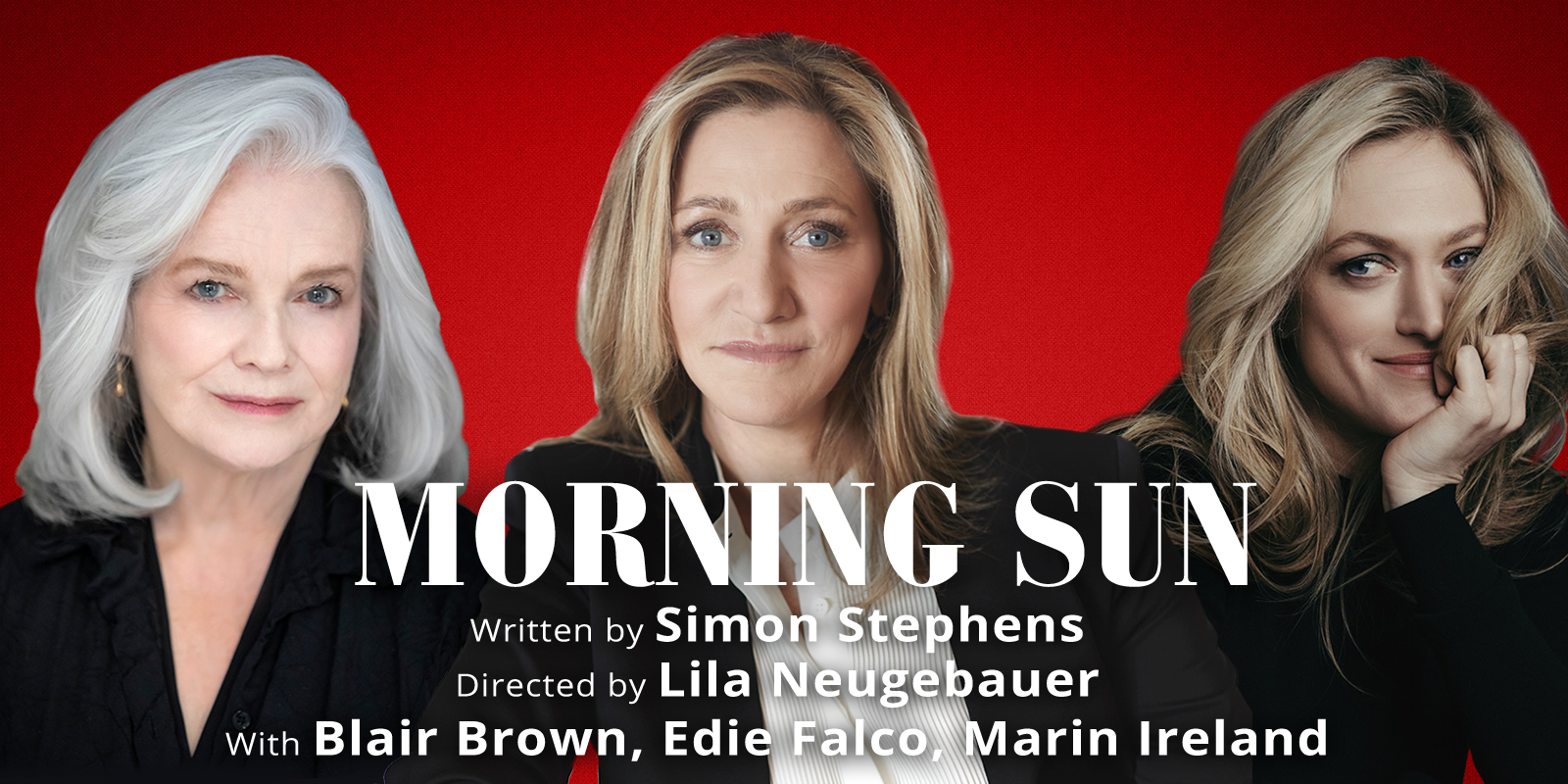
24 Oct TIO NYC: Talent to Burn, On Canvas & On the Boards!
On Broadway and in New York’s galleries, museums, and parks, more wonderful memories to write home about.
Go here for other happenings in and around New York City.

“Morning Sun” at the Manhattan Theatre Club:
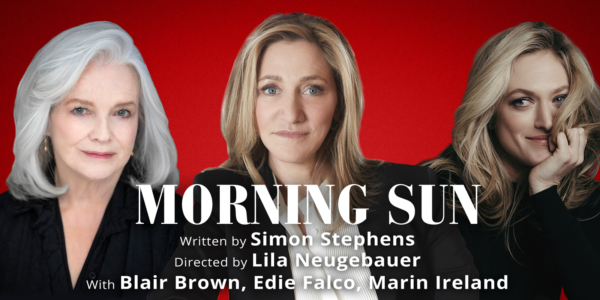
In the Age of Corona, Edward Hopper is us. The artist’s isolated figures and ghosted streets seem like a case of art imitating life.
One of Hopper’s best known works depicts a woman (modeled on the painter’s wife Jo), in a short pink slip, arms bare. She is sitting up in bed, knees pulled up to her chest looking out her bedroom window into a city sky.
That iconic painting, titled “Morning Sun,” like all Hoppers, implies a narrative in his signature spare, evocative style critics say influenced legions of photographers and filmmakers, among them Alfred Hitchcock, David Lynch, Wim Wenders – and more recently award-winning playwright Simon Stephens who penned the masterpiece “The Curious Incident of the Dog in the Night-time.”
Stephens’s latest play is a direct quote from Hopper, also titled “Morning Sun.” And here another quote, this one from Goethe, pertains. (Hopper purportedly kept these words in his wallet.):
“The beginning and end of all literary activity is the reproduction of the world that surrounds me by means of the world that is in me, all things being grasped, related, recreated, molded and reconstructed in a personal form and an original manner.”
The world of “Morning Sun,” on view now at the Manhattan Theatre Club at City Center, is set a generation or so ago, when New York city was alive and well. Joni Mitchell sings; friends and lovers come and go as do the regulars at the White Horse Tavern. As 50+ years pass, lives are revealed in all their complexities and dreams in what amounts to an enthralling reveal about mothers and daughters sharing the same Greenwich Village walk-up. The 1+ hours goes by in a New York minute. Like life itself.
Simply and elegantly directed by Lila Neugebauer, the bare bones set is intentional, allowing the light to shine (literally and figuratively) on the three extraordinary actresses who star – Blair Brown, Edie Falco and Marin Ireland. Collectively they embrace the ordinary lives of the kind of people who generally go about their business unseen. Which is most of us. (The three women also fill in seamlessly as the occasional friend, boyfriend and husband.) Each is remarkable in the fact she is unremarkable – and, as the evening passes, unforgettable. The biggest achievement of this grandmother, mother and daughter, per Stephens, is just getting through.
“What’s underneath all of it is people’s desire to connect, to be happy, not to suffer. If you can get there on some visceral level, people tend to come for the ride,” Falco told The New York Times.
Simply put, “Morning Sun” is easily one of the most memorable evenings anyone is likely to have on Broadway for some time to come. Next time you see her, you might nod a hello to the older woman standing next to you on a bus. She, we, all have stories to tell.
The Lehman Trilogy at the Nederlander:
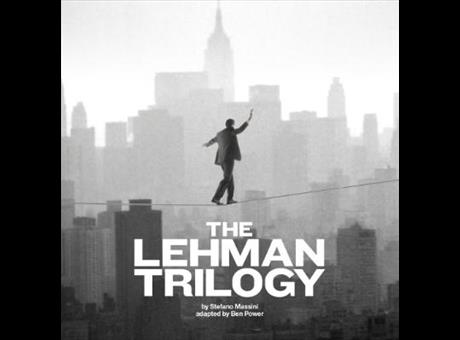
The philosophy of yin-yang holds that the universe is composed of the competing but complementary forces of dark and light, sun and moon, male and female. Generally speaking, yin is characterized as an inward energy: feminine, still and dark. Yang is characterized as outward energy, masculine, hot and bright. A neat and tidy summary of the difference between “Morning Sun” and “The Lehman Trilogy,” two of the most electrifying plays on Broadway today.
In a way “Morning Sun” and “The Lehman Trilogy,” which traces the rise and fall of the fabled financiers, are book ends: She said/He said or little people/Big People doing the full monty on the boards.
“Much of what happens in “The Lehman Trilogy” is invisible to the eye, which is not the way prestige drama usually works onstage.
“Directed by Sam Mendes, this British import, which reaches across 164 years of American history to trace the family saga behind the fallen financial powerhouse Lehman Brothers, was a scalding-hot ticket during a brief pre-pandemic run… Yet it offers almost nothing in the way of spectacle, and only the slightest of costume changes: a top hat here, a pair of glasses there.
“In the captivating production…at the Nederlander Theater, it relies largely on an unspoken agreement between actors and audience — to imagine together, and let fancy crowd out fact.
“Sort of the way that heedless investors looked right past all warning signs in the faith-based run-up to the stock market crash of 2008. Illusion is illusion, after all, and financial markets, like the theater, require a certain suspension of disbelief — though when the fantasy bursts in theater, the fallout is less ruinous. When investors halted their collective game of make-believe 13 years ago, mammoth financial firms like Lehman Brothers met their swift demise, and the world’s markets suffered the aftershocks…”
Continue reading The New York Times review here.
Yayoi Kasuma’s “Cosmic Nature”at New York Botanical Gardens (through October 31):
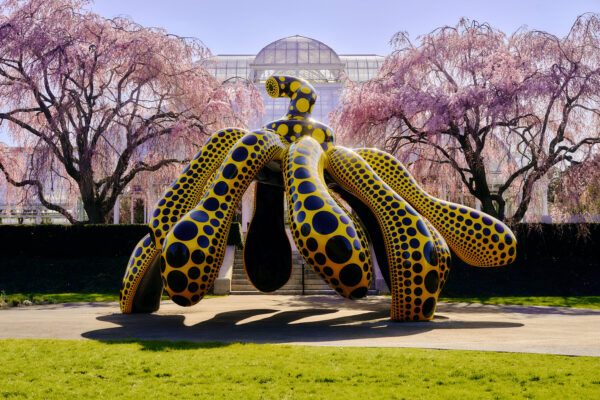
The blurb on the New York Botanical Garden’s website sums up:
“Experience Yayoi Kusama’s profound connection with nature
Contemporary Japanese artist Yayoi Kusama is one of the most popular artists in the world, drawing millions to experience her immersive installations.
Exclusively at NYBG, Kusama reveals her lifelong fascination with the natural world, beginning with her childhood spent in the greenhouses and fields of her family’s seed nursery. Her artistic concepts of obliteration, infinity, and eternity are inspired by her intimate engagement with the colors, patterns, and life cycles of plants and flowers.”
For example, in and around the Enid A. Haupt Conservatory, Kusama’s works smile brightly through a seasonal progression of violas, salvias, zinnias, chrysanthemums, and other colorful annuals. The artist’s plant-inspired, polka-dotted sculptures are nestled among meadow grasses, bellflowers, and water lilies.
Adding all-over marks and dots to her paintings, drawings, objects and clothes the artist has been quoted as saying she feels as if she is making them (and herself) melt into and become part of the bigger universe.
“Our earth is only one polka dot among a million stars in the cosmos. Polka dots are a way to infinity,” the artist has repeatedly explained.
Bottom line: Kasuma appears to be fully aligned with the Tantric world view that holds everything is made out of energy, (Shakti), inside and out, and therefore connected.
Manoucher Yektai at the Karma Gallery, 188 & 172 E 2nd Street, (through November 13):
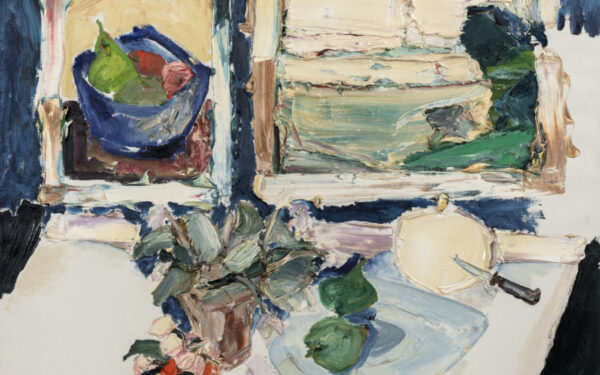
Born in Tehran, the Persian poet and Modernist American painter Manoucher Yektai is considered one of the unsung founders of the New York School of Abstract Expressionism, his work shaped and informed in part by fellow artists in that fraternity, luminaries such as Rothko, Pollock, De Kooning and Kline.
At the Karma show, the artist’s heavily impastoed oeuvre, paint as thick and delicious as icing on a cake, stands out as a vivid fusion of cultures. And because of Yektai’s love of tangible forms, his compositions include recognizable objects and never quite give it up to abstraction, creating a dynamic tension in each and every work.
Kandinsky at the Guggenheim (through September 2022):
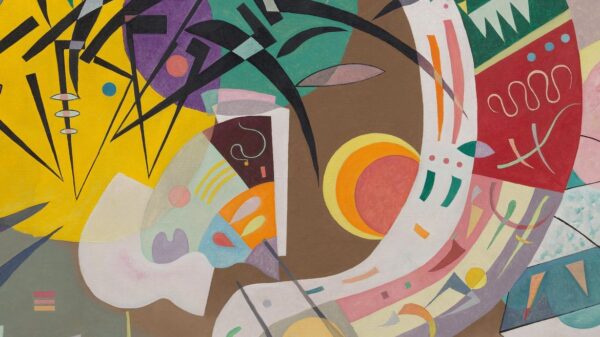
Wassily Wassilyevich Kandinsky was a Russian painter and art theorist, generally credited as being the pioneer of abstract art. The avant-guardist suffered from (or was blessed with) synesthesia, a fancy name for experiencing one of our senses through another, so it came naturally for him to exploit the evocative interrelation between color and form to create an aesthetic experience that engages sound and emotions as well as sight.
The latest show of Kandinsky’s work at the Guggenheim is titled “Around the Circle.”
“..At every turn Kandinsky responded to his environment and developed new ways to probe the spiritual in art. These paintings, watercolors, and woodcuts drawn from the museum’s extensive Kandinsky collection illuminate the journey of an artist who would not leave behind the precedents of representation or of his own work altogether, even as he explored the transcendent potential of abstract forms…,” explains the museum, which owns more of his work than of any other major Modernist and mounts some form of full-dress Kandinsky show like clockwork about every 20 years.
“..Lots of museums have foundational artists. The Museum of Modern Art has Picasso and Matisse; the Whitney Museum of American Art, Edward Hopper. But Kandinsky is the angel in the architecture at the Guggenheim; he’s part of the bedrock. The circling ramp of Wright’s rotunda was surely designed with that Russian’s swirling, unanchored abstractions in mind. Kandinsky’s precarious, ever-moving compositions suggest that he never met a diagonal he didn’t like; Wright obliged with a museum on a perpetual tilt,” wrote The New York Times about this chronological (if you go top to bottom) tour of Kandinsky’s illuminating career.
Read more about the Kandinsky show in Roberta Smith’s comprehensive, spot-on New York Times review here.


Sorry, the comment form is closed at this time.